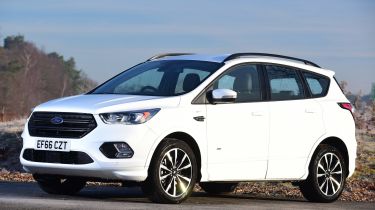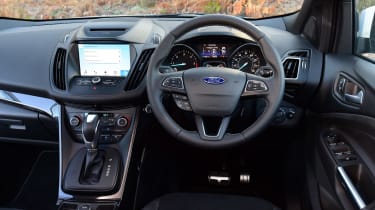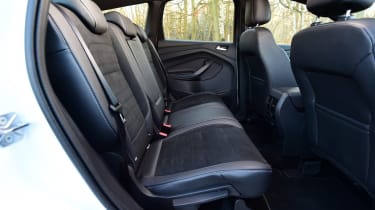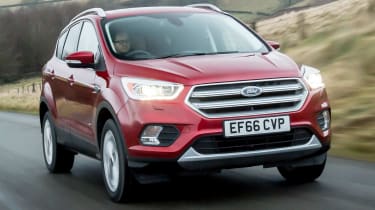Used Ford Kuga (Mk2, 2012-2019) review
A competent, good-to-drive family SUV with handsome looks and decent enough practicality – but the Ford Kuga feels its age in 2021
Verdict
The Mk2 Ford Kuga picked up where its successful predecessor left off, offering a road-biased family SUV that had more in common with the Ford Focus when it came to driving experience. It’s a practical machine for passengers but lags behind on boot space versus key rivals from Volkswagen and Honda. It’s not the most sophisticated SUV around, with an interior that hasn’t aged well plus ride and handling that’s good rather than class-leading. Still, a good example will be a very pleasant, capable and car-like companion for easy family motoring.
Which one should I buy?
- Best Kuga for low costs: Kuga 1.5 Ecoboost Zetec
- Best Kuga for long journeys: Kuga 2.0 EcoBlue Vignale
- Best Kuga for towing: Kuga 2.0 EcoBlue Titanium
A quick glance at our sister website Buyacar reveals plenty of used Ford Kuga examples for sale, and the popularity of a fashionable SUV from the Blue Oval brand should come as no surprise.
That said, the first couple of SUVs launched by Ford in the UK didn’t quite have the same impact. The Ford Maverick and Explorer were both fairly unremarkable vehicles which failed to inspire buyers in great numbers, but Ford had a bit of a rethink when the first-generation Kuga came around in 2008.
While its earlier SUVs were more traditionally rugged off-road focused machines, the Kuga was unashamedly targeted at drivers who wanted SUV style without the compromises. In fact the Kuga is unashamedly a crossover, aimed primarily at road users, and around three quarters of used examples come with only front-wheel drive.
Used - available now
Even Kugas that do come with 4x4 aren’t really geared up for off-roading; the all-wheel-drive option is more of a security blanket for driving in bad weather and slippery conditions, although the extra traction should also come in useful for owners who tow. If you need proper off-road capability, look elsewhere. The Kuga’s ultimate practicality is also compromised by the lack of a seven-seat option, but if you’re happy with five, this popular Ford SUV actually has a lot to offer.
The Kuga Mk2 arrived in November 2012 with turbocharged 1.6-litre petrol or 2.0-litre diesel engines. The petrol motor came in 148bhp and 177bhp forms, and the diesel in 138bhp and 161bhp guises. Initially there were Zetec, Titanium and Titanium X trim levels, with Titanium X Sport added in August 2013; ST-Line and Vignale would arrive in August and October 2016 respectively.
From October 2014 the 2.0 TDCi engine came in 177bhp form and the 1.6 petrol was replaced by a 1.5 EcoBoost unit. A year later Ford introduced its voice-controlled Sync 2 infotainment set-up and a raft of new driver-assistance systems.
The Kuga was facelifted in April 2016 with a redesigned dashboard, improved connectivity, a refreshed nose and a 119bhp 2.0 TDCi engine option.
Smart styling, that spacious interior and plenty of standard equipment count in its favour, although the Kuga’s infotainment system isn’t the easiest to operate, and the dash looks and feels quite low-rent. The new looks mean it's more distinctive and handsome, but overall the Kuga is starting to feel old when compared to newer arrivals such as the SEAT Ateca and Peugeot 3008. A third-generation Kuga has now been introduced, featuring mild and plug-in hybrid technology.
The post-2017 Kuga line-up mirrored that of the Focus, comprising Zetec, Titanium, ST-Line and Vignale trim levels. Standard equipment across all models is generous, with the entry-level Zetec offering 17-inch alloy wheels, a DAB radio, air-conditioning, cruise control and Ford's Sync3 system which includes sat-nav with Android Auto and Apple CarPlay connectivity. ST-Line models get a sportier look than standard, with bigger wheels and less chrome trim.
The ST-Line X model bundles extra kit together into an affordable package, especially if you're buying a Kuga on finance. At the top of the range, the luxurious Kuga Vignale has everything you could wish for, including special styling tweaks, 19-inch alloys, a 10-way adjustable electric driver’s seat, leather upholstery and leather-topped dashboard. Pre-collision assist with autonomous emergency braking is now standard across the range, as is lane-keeping aid with lane-departure warning.
What are the alternatives?
There are plenty of rivals to the Kuga, with prices ranging from around £24,000 to £38,000. The most direct rivals are the Mazda CX-5, Honda CR-V, Toyota RAV4 and Volkswagen Tiguan. But there are plenty of other options, including the SEAT Ateca and Skoda Karoq, the Peugeot 3008, the Kia Sportage and Hyundai Tucson, the Renault Kadjar and Nissan Qashqai, among many others.
If your budget is flexible, you could splash out a bit extra and buy an Audi Q3/Q5, a BMW X1/X3 or a Range Rover Evoque. All of these are more costly than the Ford, though.
Closer in price are the Nissan Qashqai and Peugeot 3008, both of which offer roomy interiors, decent equipment and some good engines. You should also take a look at the Mazda CX-5, because it’s both stylish and great to drive, comes well equipped and features a lovely interior. The Hyundai ix35/Tucson and Kia Sportage are top value and very reliable, though not as good to drive as the Kuga, while the Volkswagen Tiguan and Toyota RAV4 are also worth considering, but both are more costly than the Kuga.
Renault Koleos vs Skoda Kodiaq vs Ford Kuga
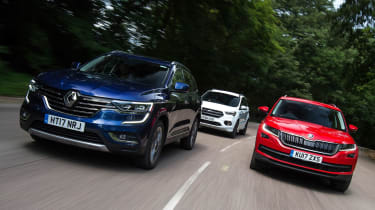
The post-facelift Kuga met some serious rivals in 2017 when we pitted it against the excellent Skoda Kodiaq and then-all-new Renault Koleos. By this point the Kuga was feeling its age – the Kodiaq was the better all-rounder and the Renault came with lots of standard equipment. Read the full test...
Honda CR-V vs Mazda CX-5 vs Ford Kuga
The facelifted Honda CR-V went up against its Mazda CX-5 and Ford Kuga rivals in 2015. The Mazda took the top spot thanks to its superior driving experience but the Kuga finished ahead of the Honda, thanks to its better value and lower running costs. Read the full test...
Ford Kuga vs Volkswagen Tiguan vs Mazda CX-5
The first test for the facelifted Kuga was in early 2017; we lined up the Volkswagen Tiguan and Mazda CX-5, both of which finished ahead of the Ford. We enjoyed the Kuga’s driving experience and improved refinement over the older model, but cited its lack of practicality, standard equipment and firm ride (in ST-Line guise). Read the full test...
How much will a used Mk2 Ford Kuga cost?
The arrival of the all-new Kuga in 2020 should mean that Mk2 prices are generally affordable. A popular model on the used market, the car appears to hold its value as well, if not as strongly as an equivalent Volkswagen Tiguan or SEAT Ateca. The good news is that there’s lots of choice and plenty of bargains to be had.
Prices
The cheapest example we found on our sister site Buyacar was a 2015 2.0 TDCi model in well-equipped Titanium trim with a shade under 55,000 miles on the clock for £11,750; increasing that budget by a couple thousand pounds lowers the mileage and can introduce four-wheel drive if you need it.
Post-facelift cars start at around £15,000 for a good example – we found a 2.0 TDCi Titanium with 35,000 miles for £15,700. The top-end of the market is where you’ll find late-model ST-Line and Vignale cars: expect to pay around £28,000-£30,000 for the very best examples with four-figure mileages.
You can check out the latest used prices for the Mk2 Ford Kuga on our Find a Car service or value a specific model using our free car valuation tool.
Fuel economy and emissions
If running costs are your priority, then go for the front-wheel-drive Ford Kuga with the 1.5-litre diesel with 118bhp, because it returns 64.2mpg and emits 115g/km of CO2. Even the more powerful 2.0-litre TDCi engine with 148bhp returns a respectable but not exceptional 60.1mpg, and has CO2 emissions of 122g/km.
The Kuga with the 1.5-litre petrol EcoBoost engine comes with 118bhp, 148bhp or 180bhp, and all have eco-friendly start-stop technology. The 148bhp variant does 45.6mpg and emits 143g/km of CO2, while the 176bhp engine returns 38.2mpg and has CO2 emissions of 171g/km.
Four-wheel drive isn't available throughout the Ford Kuga range, and only cars with the 180bhp 1.5-litre EcoBoost petrol engine and the 2.0-litre TDCi diesel units benefit from the extra traction; 54.3mpg is the best an all-wheel-drive Kuga can manage, which means it's only worth going for if you really need the extra grip.
Running costs
The Mk2 Kuga sits somewhere in the middle of the range when it comes to insurance, and costs will depend heavily on specification. Entry-level Zetec cars start in group 14, with larger engines climbing to group 22. ST-Line cars top the list with a group 16 to 27 rating depending on engine, with similarly well-equipped Vignale cars spanning groups 17 to 26.
Petrol Kugas need to be serviced every 12 months or 12,500 miles, and diesels every 12 months or 10,000 miles. The brake fluid should be replaced every two years, while all engines need their cambelt and coolant replaced every 10 years or 125k miles.
Ford offers a comprehensive range of servicing options, including an option to spread servicing costs for cars over 12 months old, along with a Ford Video Check – an electronic report detailing 30 different aspects of the car’s health.
When new, the Kuga came with a three-year, 60,000-mile warranty but an extended warranty was also available, either before or after delivery. The balance of these warranties can be transferred between owners for free, so it’s worth checking if your potential purchase has one that’s ready to be carried over.
What do owners think?
Ford has a reputation for making generally reliable cars, and that seems to be the case with the Kuga. However, owners seem to be fairly lukewarm about most of its attributes, according to our Driver Power survey. Still, pick a good example and you shouldn’t have too many issues.
Reliability
The Kuga Mk2 notched up a 43rd place in the 2019 Driver Power new car survey, as well as a 35th place in the used car poll. Its only top-20 placings in the used survey were for its brakes and infotainment system, although owners also liked its seat comfort, ride quality, performance and interior finish. Owners were less taken by the running costs, especially fuel consumption.
Rivals such as the Peugeot 3008 ranked much higher in the same survey, while the Hyundai Tucson and Kia Sportage came with better warranties (five years/unlimited miles and seven years/100,000 miles respectively) and were rated higher for reliability.
How practical is it?
The Ford Kuga was (and still is) a contender in a highly competitive segment of the market – one where practicality is a key consideration for buyers. However, while passenger space is ample, a number of key rivals beat the Kuga on boot space.
Dimensions, cabin and boot space
The Kuga doesn’t feel too big compared to its rivals, its height giving you a useful view over traffic ahead. It feels longer than most, looking a bit like a tall estate car rather than a chunky SUV or crossover. That’s to its benefit in traffic, where you feel more confident threading it through gaps.
Passenger space in the Kuga is good for four adults but the fifth middle seat is a bit of a squeeze unless you’re all very friendly. Headroom and legroom are good, too, but the panoramic glass roof – standard on some models – could be a problem for taller passengers. Visibility is generally decent all round.
The Kuga still has a reasonable 456-litre boot, while the rear seats fold down easily to reveal a 1,603-litre load area that’s nice and flat.The boot is smaller than you’ll find in a Volkswagen Tiguan and Honda CR-V, while even the smaller SEAT Ateca and Peugeot 3008 also beat it for space. Furthermore, the spare wheel option decreases boot space to 406 litres, giving it 97 litres less than a Mazda CX-5.
There’s a compartment under the boot floor for secreting away items out of sight. If that floor panel is in its high position and the seatbacks are down, the load space is flat and the seats themselves fold in a simple one-hand operation across the entire range. There's a low loading lip, too, so getting items in and out is easy. An automatic tailgate can also also be added, which can be opened by waving your foot under the rear bumper (as long as you have the key in your pocket).
Equipment and technology
It’s well worth going for the post-facelift Ford Kuga if you favour up-to-date technology. The car’s interior was much the same as pre-facelift models’, but added the much improved SYNC 3 infotainment system. This unit abandoned the previous SYNC 2’s four-way home screen in favour of a fresh-looking eight-inch layout; the main screen features the standard sat-nav overlaid by large shortcut keys for the phone and stereo. Other functions are easily accessed via a menu bar that runs along the bottom of the screen.
There's loads of kit in the Kuga. Even on the entry-level Ford Kuga Zetec models, 17-inch alloy wheels, sports seats, daytime running lights, cruise control and keyless go are standard. Go for the Ford Kuga Titanium and you get a gloss-black grille surround, part-leather seats, automatic headlights, dual-zone climate control, the Ford SYNC phone voice-control system and a DAB radio. The range-topping Ford Kuga Titanium X trim adds 18-inch alloys, LED tail-lights, bi-xenon adaptive headlamps, a panoramic roof and leather upholstery.
The facelift also added adaptive cruise control, Apple CarPlay and Android Auto integration, a touchscreen sat-nav, powered tailgate, electric heated seats, a heated steering wheel and some neat alloy wheels to the kit list, while a new ST-Line model adds some sporty body trim to the exterior look.
The Ford Kuga Vignale offers buyers a top-spec car that's supposed to rival premium rivals such as BMW or Mercedes, but in reality it's an overpriced Kuga with leather seats and some extra kit. This trim level made little sense when the car was new but could be a bit of a used-car bargain today.
Safety
A five-star Euro NCAP crash test rating should reassure you if you’re buying a Kuga as a family vehicle. The standard safety equipment list is lengthy, with ABS, Emergency Brake Warning, driver and front airbags, a driver’s knee airbag, front side impact airbags and front and rear curtain airbags all as standard.
All Kugas also got tyre pressure monitoring and two Isofix child seat mounts. If the original owner checked the right options boxes, Active City Stop was added – a system that helps to prevent slow-speed accidents by slowing the car down if you don’t brake – plus blind-spot monitoring. Also available were Traffic Sign Recognition, Adaptive Cruise control and Lane Keeping Aid.
What’s it like to drive?
The first-generation Ford Kuga was famed for its near class-leading drive, but the Mk2 was merely up to par with its more modern rivals in this regard, rather than outstanding. It's not bad to drive, but the SEAT Ateca is a more composed and agile SUV in the bends.
Engines and performance
The 2.0-litre, four-cylinder TDCi engine was offered in two states of tune – 148bhp or 178bhp – with the lower-output version offered in either front- and four-wheel drive; the more powerful unit is four-wheel drive only. There was also a 118bhp 1.5-litre diesel, as well as a 118bhp petrol EcoBoost engine of the same displacement, with 148bhp and 180bhp petrol options also available.
The 148bhp 1.5-litre EcoBoost petrol engine is mated to either a six-speed manual gearbox or a dual-clutch PowerShift automatic. The manual gearbox is well-weighted and pleasing to use, so while the auto isn't bad it isn't ideally suited to this engine choice.
Most buyers should go for the 148bhp or 178bhp 2.0-litre diesel models because they offer the best combination of power and efficiency. Both are smooth, with noise levels well isolated from the cabin, and deliver decent in-gear pace, with either manual or automatic gearboxes.
Less impressive is Ford's Powershift auto gearbox. The six-speed unit delivers smooth and rapid shifts when cruising, but at low speed it trips over itself and struggles to find the right gear. On the plus side, there are now handy gearshift paddles instead of the old car’s tiny, lever-mounted rocker switch.
On the road
The steering is better weighted than in rivals and feels more precise, while stiffer suspension on ST-Line models mean they don’t roll as much in corners, either.
Torque vectoring helps improve power delivery while you’re turning by braking the inside wheels, which makes it feel more agile – and Ford’s four-wheel-drive system helps send grip where it’s needed for improved traction. Sport mode in the Kuga adds some steering weight and holds on to gears in the auto model, and the Ford also gets shift paddles behind the steering wheel.
Stiffer suspension helps the Kuga control its mass in corners but it results in a firm ride, especially at low speed. It’s not uncomfortable, but rivals are smoother. The Kuga features a comprehensive list of electronic driver aids, with options such as Active City Stop, Traffic Sign Recognition and Lane Keeping Alert offered as part of a Driver Assistance Pack.
What should you look out for?
While there are relatively few known issues to look for when buying a used Kuga, the car had more than its fair share of recalls over the years. Make sure you check with a local dealer to make sure yours has had any required remedial work, free of charge.
Common used Ford Kuga problems
Tailgate
A knocking noise from the rear could be the striker plate for the back door, which will need greasing.
Trim
Most of the interior trim tends to wear pretty well, but not the gearlever gaiter. A new one is cheap, though, so you can always replace it.
Doors
Hearing creaking sounds from the front doors isn’t an unusual occurrence; simply applying rubber seal treatment to the seals should fix things.
Gearbox
The Powershift automatic gearbox works well enough, but it needs fresh oil and filters every three years, at £200 a time.
Recalls
The first recall to affect the Mk2 Ford Kuga was issued in 2017 and concerned B-pillar insulation that could catch fire in collisions where the front seatbelt pre-tensioner has activated. Nearly 30,000 cars were affected, built between July 2012 and Jun 2014 inclusive.
A second recall issued in 2017 concerned side and/or knee airbags not deploying in an accident because of a defective airbag initiator. Just under 2,000 Ford cars were affected, including Kuga models built between July and December 2016 inclusive.
The first of three recalls issued in 2018 was related to the potential for cylinder heads to crack on certain models, causing pressurised oil leaks and, in some cases, fires. 15,228 Ford cars were affected, among them Kuga models produced between June 2010 and December 2014 inclusive. The second recall was for certain 2.0-litre Duratorq diesels, which could overheat and leak oil: some Kugas built between October 2014 and September 2015 (inclusive) were affected.
The third recall of 2018 was for certain Kuga models built between August 2013 and June 2016 inclusive – some Ecoboost engines fitted with six-speed manual gearboxes could suffer from a clutch pressure plate fracture. A similar issue also affected models built between June 2016 and May 2018 inclusive.
Four more recalls were issued for a variety of reasons in 2020 and into 2021, but these largely affect the newer model. Still, if your Mk2 Kuga is an end-of-the-line model, it pays to get in touch with your local dealer to make sure it is not affected.
